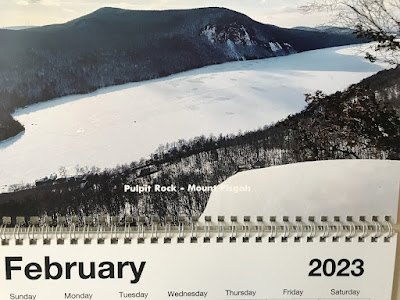Physics Photo of the Week
Physics Photo of the Week
February 24, 2023
Freezing of lakes - calendar photo by Elaine Cashen's daughter
Willoughby Lake (Lake Willoughby) in northern Vermont is an impressive mountain lake that resembles a coastal fjord that lies between two steep mountains. The winter photo appears on a calendar produced by a fundraiser for the Westmore Association which has as its principle interest the preservation of the pristine nature of this beautiful lake. The photo was taken from Pulpit Rock - an outcrop on the steep slopes of Mount Pisgah - easily accessible with a mile long trail - in the summer. The mountain on the far side of the lake is Mount Hor that also show very steep slopes.
 Willoughby Lake is deeper than most of the lakes in the area - reaching a maximum depth of about 330 feet roughly in the area of the shadow of Mount Hor on the snow-covered ice. I have a habit of observing the weather satellite images of the northeastern US on a daily basis to notice when the area lakes are frozen. They show up as white in the satellite images due to the snow that usually covers the frozen lakes. The satellite image at right is the first image this winter that I could see that the lake was frozen. The area is usually cloud-covered in the morning satellite images. About a week ago, Willoughby Lake was still not frozen over, wheras a nearby large lake (Seymour Lake) had already frozen over. Both lakes are indicated on the satellite photo with their initial letters.
Willoughby Lake is deeper than most of the lakes in the area - reaching a maximum depth of about 330 feet roughly in the area of the shadow of Mount Hor on the snow-covered ice. I have a habit of observing the weather satellite images of the northeastern US on a daily basis to notice when the area lakes are frozen. They show up as white in the satellite images due to the snow that usually covers the frozen lakes. The satellite image at right is the first image this winter that I could see that the lake was frozen. The area is usually cloud-covered in the morning satellite images. About a week ago, Willoughby Lake was still not frozen over, wheras a nearby large lake (Seymour Lake) had already frozen over. Both lakes are indicated on the satellite photo with their initial letters.
Why did Willoughby Lake freeze over considerably later than nearby Seymour Lake? These two lakes are about the same size, although Seymour Lake has a slightly larger surface area. The weather is very similar due to their proximity. The major difference is the depths of the two lakes. Willoughby Lake has about twice the maximum depth as Seymour Lake. The freezing time for lakes is quite complicated but depends on the depths of the lakes.
The water temperature well below the surface of lakes stays at a constant temperature of about 13 deg C (55 deg F). I call this the "wine cellar" effect. Cellars, mines, caves are isolated from the above ground weather and remain a very constant temperature - unless subject to geothermal heating from nearby volcanoes. Lakes never freeze solidly all the way to the bottom of the lakes. In very cold winters, the maximum ice thickness is not more than about 2 feet. Water is most dense at about 4 deg C (40 deg F). When the surface water cools below this temperature, it becomes less dense and stays at the top and can freeze. When the surface temperature is cooling in the early winter and has not yet cooled below 4 deg C, the convection between the top layer and the warmer lower layers keeps the surface stirred-up - preventing the freezing at the surface. The convection currents penetrate deeper in a deeper lake thus delaying the initial freezing at the surface. The surface winds also are a factor as well as a layer a few meters below a lake's surface called the thermocline - the layer where the temperature changes abruptly from close to the surface temperature to the base "wine cellar" temperature. Convection during surface cooling causes lakes to "turn over" before freezing when the surface waters become interchanged with the bottom layers. The reverse happens after ice-melt in the spring. In the summer, deep Willoughby is always colder to swim in than the nearby shallower lakes.
All this explanation involves considerable conjecture on my part. I have never taken any research measurements of temperature profiles of the lake and have never visited these lakes in the winter. The evidence is mostly anecdotal.
======================================================================
Physics Photo of the Week is published weekly during the academic year on Fridays by the Warren Wilson College Physics Department. These photos feature interesting phenomena in the world around us. Students, faculty, and others are invited to submit digital (or film) photographs for publication and explanation. Atmospheric phenomena are especially welcome. Please send any photos to dcollins@warren-wilson.edu.
All photos and discussions are copyright by Donald Collins or by the person credited for the photo and/or discussion. These photos and discussions may be used for private individual use or educational use. Any commercial use without written permission of the photoprovider is forbidden.




Comments
Post a Comment